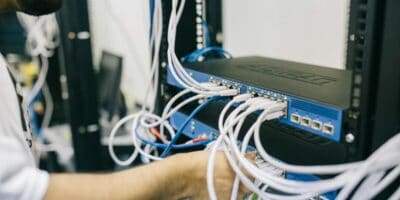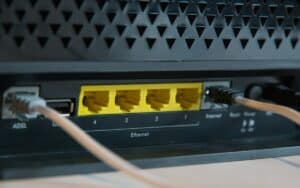Modern office infrastructure has evolved far beyond the traditional cubicle setup. Modern designs focus on how space can best enhance productivity, collaboration, and employee well-being. Businesses can now integrate audiovisual systems, workspace management systems, smart building technology, and other applications into their designs. It’s an exciting time, but with these innovations comes an increased reliance on high-speed connectivity. When connectivity needs outpace available infrastructure, it may be time for PoE office technology upgrades.
Facility managers (FMs) and operational leaders, in general, are faced with an ever-expanding need to optimize procedural frameworks, harmonize data streams, and unify networks while conserving energy and reducing costs. PoE office technology upgrades increase data rates for faster data exchange and improved energy efficiency.
What is the role of technology in enhancing business?
Technology empowers businesses to operate more effectively and deliver greater value to their customers by:
- ImprovingCommunication: Technology enables instant communication and collaboration between employees, partners, and customers.
- Facilitating Data Management: New technological tools exist to collect, store, and analyze data more effectively, enabling better decision-making.
- Expanding Market Reach: Businesses can connect with customers globally through digital marketing and e-commerce.
- Increasing Efficiency: Routine tasks can be automated, processes streamlined, and manual errors reduced.
- Enhancing Security: Smart cameras, sensors, alarms, data access control systems, and real-time monitoring features protect assets and reduce response times in the event of a security incident.
- Improving Customer Experience: With convenient services and online support, technology makes interactions more personalized and helpful for customers.
Technology plays a crucial role in business by improving efficiency and security. It fosters innovation and growth by enabling modern office work, encouraging creativity, and providing access to new markets.
Can technology lead to cost reduction?
Companies today understand that investing in technology is essential for doing business. To keep up with consumer demand and competition, even small companies can benefit from upgrading their computing software and digital tools to access improved financial management and process control.
In an office setting, technology:
- Lowers material costs: Digital documentation eliminates the costs related to printing and mailing, including paper, ink, postage, and shipping.
- Saves time: Automating manual processes saves workers time by facilitating vital activities like collaboration, contract negotiation, employee onboarding, customer acquisition, and more.
- Increases productivity: Technology offers a clear path to optimized productivity and profit maximization.
Technology cuts costs by simplifying business processes and reducing the administrative burden required to complete basic tasks. Combining PoE with office technology further reduces costs by streamlining installation and enabling control of office automation systems via a single PoE switch.
How do higher data rates reduce transmission time?
As mentioned above, one crucial limiting factor of network technology is the speed of data transmission. Data Transfer Rate (DTR) refers to the amount of data that can be transmitted through a network in a given period and is measured in megabits per second (Mbps) or Gigabits per second (Gbps). Only a finite amount of data can be transmitted within a given timeframe on a network’s established data pathways.
Increasing the DTR of a network through processes like time division multiplexing and data compression can effectively widen these data highways.
Time Division Multiplexing (TDM)
Time-division multiplexing (TDM) enables devices to transmit more data simultaneously through multiple streams. It works by dividing a single data stream into frames and then further dividing those frames into time slots. The number of signals that need to be transmitted, combined with the available bandwidth, determines the number of time slots per frame. Each signal is transmitted during an allocated time slot without interfering with other signals.
With TDM, larger volumes of data can then be shared in parallel, minimizing the need for prolonged communication sessions. This reduces congestion, accelerates the overall data exchange process, optimizes the time devices spend in active mode, and reduces energy consumption.
Advanced Data Compression
Data compression techniques reduce the amount of data that needs to be transmitted, resulting in shorter transmission times and reduced power consumption. Operating at the session layer, layer 5 of the seven-layer OSI model, advanced data compression compresses homogeneous data sets to generate higher system throughput while minimizing latency. Synchronization and resynchronization techniques at the session level ensure reliable and orderly data transmission over networks. This is particularly important in applications requiring high levels of data integrity and continuity.
How can higher data rates increase energy efficiency?
The operational cycle of network devices reinforces the relationship between higher data rates and energy efficiency. Devices remain active while data is transmitted. Because this active state consumes energy, it adds to the network’s overall power consumption.
When the rate of data transmission increases, the time network devices need to stay active decreases. This reduces the energy consumed during transmission.
How can PoE office technology upgrades make the workplace more efficient?
Technology is a key enabler of workplace efficiency. Diverse tools, such as visitor management networks, access control systems, space booking tools, and automated monitoring systems, provide FMs with control over space and the ability to gather real-time data. This allows for predictive maintenance, helping to ensure that facilities are functioning optimally. Improved office technology means less downtime, better data management, enhanced productivity, and a better experience for all stakeholders.
Introducing PoE into office technology upgrades can further reduce costs, make office layout customization easier, and improve the functionality of connected devices. Because PoE devices are smart and can turn on and off automatically, they’ll draw less power than legacy devices. Because PoE devices require only a single cable to receive both data and power, they increase safety while reducing the costs associated with installations.
The higher data rates PoE provides offer energy efficiency and optimized power management by using tools like:
- Voltage Drop Compensation: Advanced algorithms dynamically adjust power levels to compensate for voltage drop.
- Enhanced Power Scheduling: Increased data throughput enables smarter power scheduling.
- Reduced Standby Power: Devices can complete their tasks more quickly, allowing them to spend more time in low-power states.
The C62-084-91-770 L2 Managed 8-Port 10/100/1000 802.3bt PoE switch from Versa Technology features 8 PoE ports, 2 GbE ports, and 2 SFP ports. The switch has an operating temperature range of 0ºC to 50ºC and a PoE power budget of 720W. The switch also serves as an IP camera controller and features a centralized Web GUI (Graphical User Interface). These features provide oversight and management of powered devices, ensuring sufficient PoE power to support any application a modern office might need.









